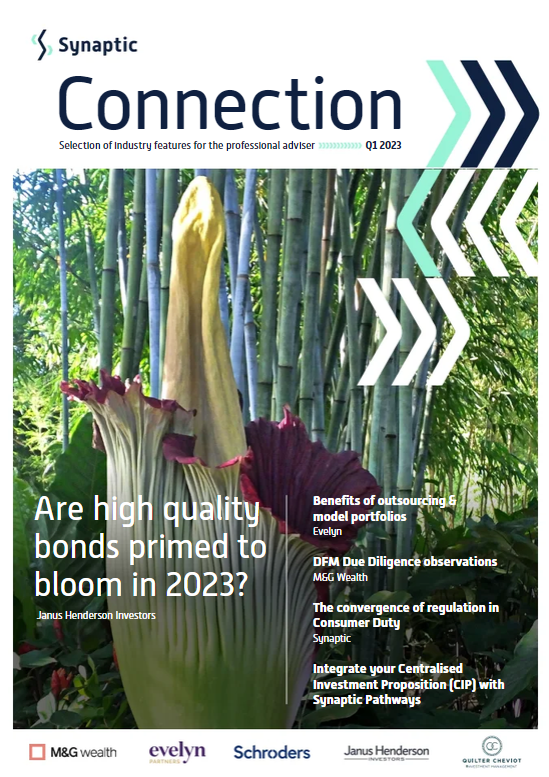In this edition...
- What we know – and what we don’t Patrick Farrell, Chief Investment Officer and Head of Research - Charles Stanley
- Regime shift: five seismic adjustments taking place in the global economy Azad Zangana, Senior European Economist and Strategist - Schroders
- How to navigate a recession Mike Coop, Morningstar Investment Management - EMEA
- High quality bonds are primed to bloom in 2023 John Pattullo, Co-Head of Global Bonds- Janus Henderson
- Fixed Income - Research Matters Andrew Metcalf, Fixed Income Portfolio Manager - Close Brothers Asset Management
- From 'TINA to 'TANIA'... Bryn Jones, Head of Fixed Income - Rathbones
- The RSMR Broadcast: How impactful is investment management outsourcing? Scott McNiven, MPS Accounts Manager - RSMR
- Hours to minutes Synaptic,
- Benefits of outsourcing and model portfolios Evelyn & Partners,
- DFM Due Diligence – some observations Sean Hawkins, Head of Business Development - M&G Wealth Investments
- 2022 – The death knell for the 60/40 approach to investing? John Husselbee, Head of Multi-Asset - Liontrust
- Why ‘nature positive’ will be as big as net zero Jenn-Hui Tan, Global Head of Stewardship & Sustainable Investing - Fidelity International
- The rise of the female investor Vanessa Eve, Investment Manager - Quilter Cheviot
- Integrate your Centralised Investment Proposition (CIP) with Synaptic Pathways Eric Armstrong, Client Director - Synaptic
- The convergence of regulation in Consumer Duty Eric Armstrong, Client Director, Synaptic
- Tackle Consumer Duty with the new Synaptic integration Alan Lakey , Director - CIExpert & Highclere Financial Services Ltd
 2022 was a year of global volatility and uncertainty with the war in Ukraine, soaring inflation and political upheaval in the UK all combining to make it a dark year for investment. The dramatic underperformance of both equities and bonds during this period has led some to question whether 2022 sounded the death knell for the famous 60/40 approach to investment.
2022 was a year of global volatility and uncertainty with the war in Ukraine, soaring inflation and political upheaval in the UK all combining to make it a dark year for investment. The dramatic underperformance of both equities and bonds during this period has led some to question whether 2022 sounded the death knell for the famous 60/40 approach to investment.
A balanced portfolio has long been the mantra for investors and the 60/40 approach – holding 60% of the portfolio in equities and 40% in bonds – has largely reaped rewards by ensuring investors are hedged against falls in either asset class. So, what went wrong in 2022 and what are the prospects for a 60/40 approach in 2023?
Historically bonds and equities are negatively correlated. Yet in 2021 and particularly in 2022, bonds failed to provide the diversification of returns seen in many prior years. In fact, in 2022 government bonds suffered their worst returns in 20 years (with 2021 ranking second worst). To put it bluntly, in 2022 diversification failed, with one of the highest correlations between equity and bonds ever recorded.
This was fundamentally the result of an exceptional set of macroeconomic headwinds which saw inflation soar to 40-year highs. This perfect storm of events included:
• A health crisis – still dealing with a global pandemic, China retained its zero Covid policy.
• A geopolitical crisis – Russia unexpectedly invaded Ukraine, fuelling further energy and food price inflation.
• A climate crisis – the biggest drought in Europe for 500 years and a heatwave which saw temperatures soaring above 40°c.
• A political crisis in the UK – three prime ministers and four chancellors.
• A fiscal crisis in the UK – Kwasi Kwarteng’s failed mini budget which saw sterling plummet and gilt yields soar.
As inflation remained stubborn and continued to climb, central banks decided it was necessary to take rapid and aggressive action leading to interest rates rising steeply across the world. This was shown not least in the Federal Reserve’s decision to hike rates to 4% in just nine months – in comparison it took it two years to do so in the 2004/06 cycle. The combination of soaring inflation and rapidly rising interest rates proved unmitigated bad news for bonds and equities.
"Since the global financial crisis, the bond risk/reward equation has been distorted by quantitative easing and zero interest rate policy. However, this is no longer the case and central banks now have the monetary tools to deal with the next crisis."
So what next?
Several months on, we believe we are closer to the peak in interest rates. This month saw the Bank of England increase the base rate by 0.5 percentage points, to 4%; the Federal Reserve put up rates by 0.25 percentage points; and the European Central Bank hike rates by 0.5 percentage points.
Yet while the market is currently pricing in another four 25 basis point interest rate hikes, we think this is unlikely. Given that inflation peaked at 11.1% in October of last year and is now predicted to fall to 2.5% in 2024 (not far off its 2% target) and the UK economy is expected to suffer a shallow recession this year, there seems limited need for further tightening.
Many issues driving inflation have been addressed – pre-invasion Russia supplied 40% of Europe’s energy needs, but this has fallen to nothing today. However, there are still inflationary challenges in the UK, including ongoing public sector strikes, potential wage spirals, and the cost of lost days of work to the economy. And while global inflation is slowing, so is global economic growth which poses its own risks.
While the last recession was induced by governments locking down the economy through a global pandemic; this one is being induced by central banks wanting to kill inflation. However, it is not yet clear whether the recession will be a soft or hard landing and this will vary across markets. Certainly, we will start to see divergence in central bank policy as the world continues to decouple – the US may avoid a recession whereas Europe may already be in a recession.
However, overall, the picture for the 60/40 approach is looking decidedly better than it was last year.
Following 2022’s market repricing, 2023 has already seen a sharp pick up and there are plenty of asset classes offering investors attractive yields – from pockets of the equity market to the lower-quality reaches of the fixed income markets, where yields on corporate bonds are high at around 5%, albeit due to a higher risk premium.
This double positive is likely to revert to the more typical correlation between bonds and equity prices over the coming months. In the first half of this year tension between central banks and markets is likely to mean what is good for bonds is also good for equities. But by the second half of 2023 inflation should be coming under control, and the market focus should move on. It is then that the negative correlation should reassert itself.
We have covered rates, recession and risk and what the picture might look like for these concerns in 2023. However, another ‘R’ to consider is repricing, particularly in light of the 60/40 portfolio approach.
Both global equities and bonds are cheaper than 12 months ago. The process of repricing has been painful, but the yield landscape has completely transformed in a year and sovereign yields are back to levels last seen a decade ago. Meanwhile equities repriced very early to the changing discount rates, falling back to the lower end of their valuation ranges.
Since the global financial crisis, the bond risk/reward equation has been distorted by quantitative easing and zero interest rate policy. However, this is no longer the case and central banks now have the monetary tools to deal with the next crisis, while balanced portfolios have the downside protection from bonds.
It is also worth noting that since 1928, 2022 was only the fourth time that US bonds and US equities both lost money. The other periods of time where the ‘double negative’ was recorded were 1931, 1941 and 1969.
The road, however, is rarely smooth. For long-term investors, there is a need to embrace volatility and it is likely that over the coming year there will be periods of below average trend returns, similar to those seen in 2022. However, with the repricing of bonds and equities it may be a good time to look again to balanced portfolio investing. Claims of the death of the 60/40 approach may be premature.
Get in touch
Key Risks:
Past performance is not a guide to future performance. The value of an investment and the income generated from it can fall as well as rise and is not guaranteed. You may get back less than you originally invested.
Disclaimer:
This communication is issued by Liontrust Fund Partners LLP (2 Savoy Court, London WC2R 0EZ), authorised and regulated in the UK by the Financial Conduct Authority (FRN 518165) to undertake regulated investment business.
This is a marketing communication. Before making an investment, you should read the relevant Prospectus and the Key Investor Information Document (KIID), which provide full product details including investment charges and risks. These documents can be obtained, free of charge, from www.liontrust.co.uk or direct from Liontrust. Always research your own investments and if you are not a professional investor please consult a regulated financial adviser regarding the suitability of such an investment for you and your personal circumstances.
This should not be construed as advice for investment in any product or security mentioned, an offer to buy or sell units/shares of Funds mentioned, or a solicitation to purchase securities in any company or investment product. Examples of stocks are provided for general information only to demonstrate our investment philosophy. The investment being promoted is for units in a fund, not directly in the underlying assets. It contains information and analysis that is believed to be accurate at the time of publication, but is subject to change without notice. Whilst care has been taken in compiling the content of this document, no representation or warranty, express or implied, is made by Liontrust as to its accuracy or completeness, including for external sources (which may have been used) which have not been verified. It should not be copied, forwarded, reproduced, divulged or otherwise distributed in any form whether by way of fax, email, oral or otherwise, in whole or in part without the express and prior written consent of Liontrust.
Sign up for updates
Keep up to speed with everything you need to know each quarter, by email or post.


